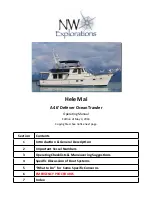
At this point, the boat should be able to be launched with a light shove or by backing off the trailer under power.
Finish loading your boat at a sufficient distance from the ramp so that others may use it.
Retrieval
The steps for removing your boat from the water are basically the reverse of those taken to launch it. However,
keep in mind that certain conditions may exist during retrieval that did not exist during launching. As you
approach the takeout ramp, take special care to note such factors as the change in wind direction and/or velocity,
the change in current and/or tide, any increase in boating traffic, visibility, etc.
•
Unload the boat at a dock or mooring if possible.
•
Back down the ramp so that the trailer is half submerged.
•
Maneuver the boat carefully to the submerged trailer, and raise the lower unit of the engine.
•
Carefully line up the boat, slowly maneuvering with short bursts of power.
•
When the keel is centered and the boat is just touching the trailer winch, smoothly apply power
until the boat eases to the bow rest.
•
Winch the boat onto the trailer and secure it.
•
Drive the trailer with the boat aboard carefully out of the ramp to a designated parking area for
cleanup, reloading, and an equipment safety check.
•
Remove the drain plug.
•
Rinse off the salt water as soon as fresh water is available.
•
Stow the equipment, canvas, etc. and affix the tie downs and covers.
•
Hook up the trailer lights and verify their operation.
Practice will make launch and retrieval a simple procedure. The best advice is just, "do it cautiously with safety as
your main concern."
Storage
Since your boat may be sitting on its trailer for quite some time before it is used again, it is important that it be
stored properly. To avoid damage from sun and weather, cover the boat with a tarp. To remove weight from the
wheels, put cinderblocks or wood beams under the tongue and all four corners of the trailer frame.
39












































